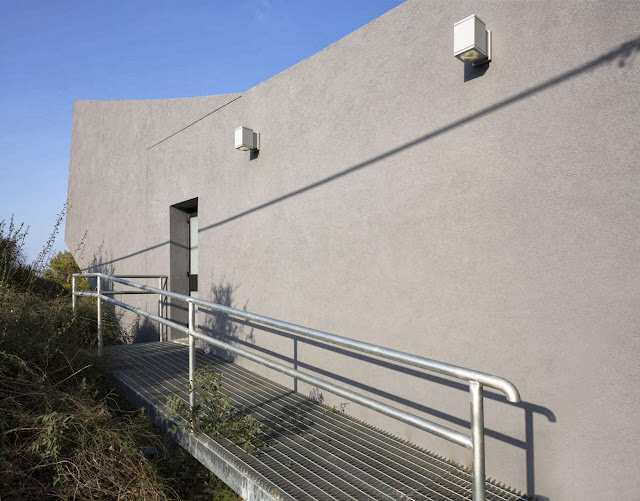Nesher Memorial was built on a basis of an historic preservation building that was used in the past as a guarding position.
The building is located on a hilltop surrounded by a large square and a children’s playground. Prior to the construction works, the building was neglected and was used in favour of the public only once a year – in the National Memorial Day, then it was open for a tour and impression of memorial pictures, as a part of the public ceremony for the memory of the fallen.
Nesher municipality asked SO Architecture office to expand the square surrounding the building so it will enable multiplayer events, and to redesign the building and add functions to it, so that it can serve the public throughout the year as a gathering space.
The main architectural idea was to add to the existing building an auditorium structure that could be used for different kinds of public activities such as lectures, film screenings, activities of youth groups, etc., along with preservation of the historical memory.
The auditorium reveals its insides geometry to the park and the city surrounding, by its inclined façade. This geometrical act has an additional meaning in creating a symbolic geometry that communicates with the memorial concept, and the function of the building as a monument.
A large window is located at the edge of the auditorium, facing north and thus brings a soft light into the auditorium and enables a breathtaking view at the landscape of Haifa bay. In a poetic allegory to reality, the window function as a bright ending to the inner space, and thus symbolizes the balance between the bereavement pain and the light and hope in the living world.
A box for each fallen, with its picture on it, is hanged on the wall of the memory area inside the building. Inside it, there is a room for storage of memorial personal belongings that the family and the municipality can put. In the space itself there is a place for seating and communion with the memory books and the memory of the fallen.
The centre of the memory space is lighted by long and narrow windows that were the shooting slits in the original guarding position, and by upper skylight windows from the original historic building. The memory space was designed in a modular manner, so that if necessary, it will be possible to add additional boxes without any difficulty.
The original building contours regarding to the addition, are marked and highlighted through aluminium bars that were sediment in mortar and emphasize the contours of the old building regarding to the new addition. The materials that we used in the building are simple.
The floor in the memory space is a concrete floor. The ceiling along the whole building is covered with oak planks, so that it creates a warm atmosphere. The auditorium area was also covered with wood, and sponge padded seats. An access to disabled was also arranged.
Location: Giv’at Nesher, Israel
Architect: So Architecture
Project Team: Shachar Lulav, Oded Rozenkier, Alejandro Fajnerman, Tomer Nahshon, Samer Hakim
Area: 118 Sqm.
Year: 2013
Client: Nesher Municipality
Photoes: Shai Epstein
Architect: So Architecture
Project Team: Shachar Lulav, Oded Rozenkier, Alejandro Fajnerman, Tomer Nahshon, Samer Hakim
Area: 118 Sqm.
Year: 2013
Client: Nesher Municipality
Photoes: Shai Epstein
















